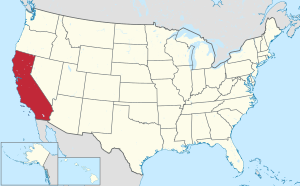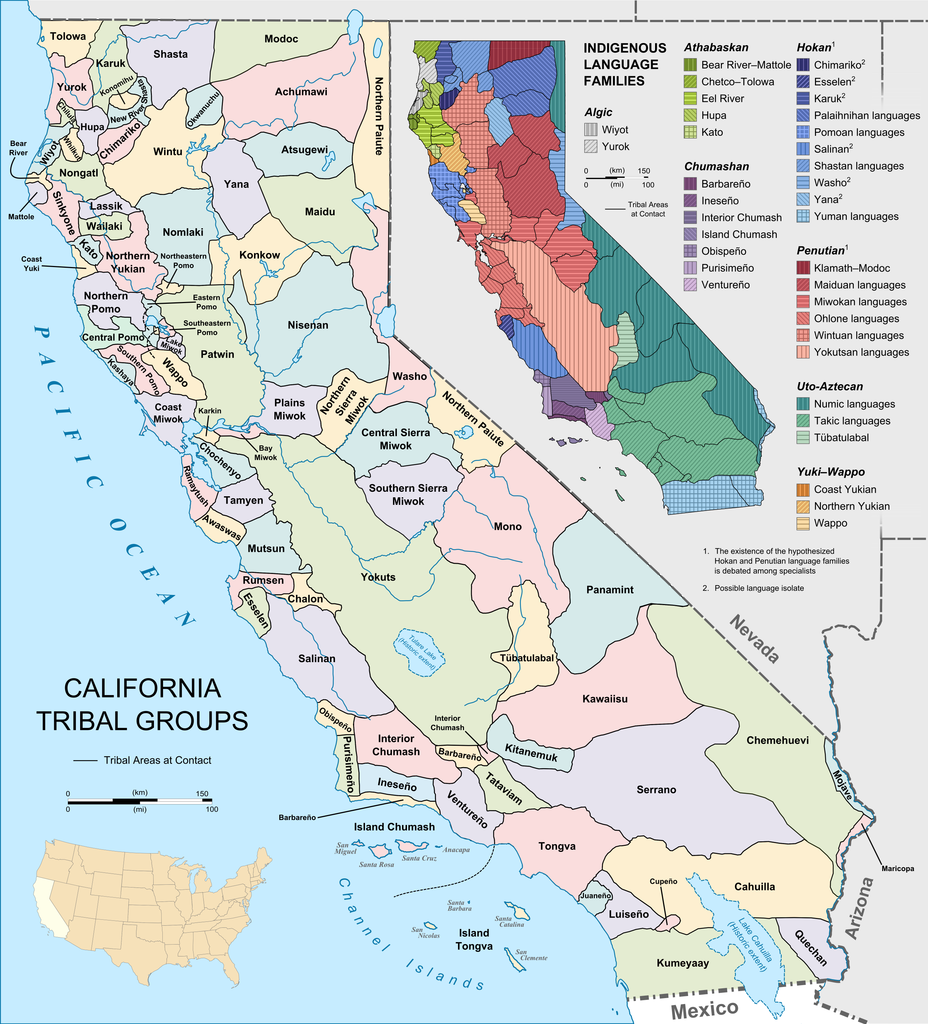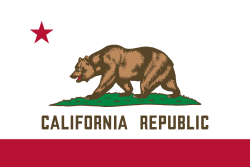More languages
More actions
Verda.Majo (talk | contribs) mNo edit summary Tag: Visual edit |
No edit summary Tag: Visual edit |
||
| Line 11: | Line 11: | ||
The earliest human occupation in the area of the state dates back 19 thousand years. The Indigenous peoples of California spoke a minimum of a hundred different languages at the time, had their own specific food cultures, and distinct religious beliefs. In the late 18th century, over 300,000 people were living in the state.<ref name=":0" /> | The earliest human occupation in the area of the state dates back 19 thousand years. The Indigenous peoples of California spoke a minimum of a hundred different languages at the time, had their own specific food cultures, and distinct religious beliefs. In the late 18th century, over 300,000 people were living in the state.<ref name=":0" /> | ||
From 1769 to 1800, the California coast was under Spanish control from San Francisco in the north to San Diego in the south. The Spanish mission system was a method of colonization in the area that used religious doctrine heavily in its self-justification. The Spanish used Native Californian's labor to build the missions and abused, exploited, and murdered the people. Meanwhile, Native Californians consistently resisted Spanish rule.<ref>[https://www.nps.gov/parkhistory/online_books/5views/5views1b.htm “Five Views: An Ethnic Historic Site Survey for California (American Indians).”] 1988. Nps.gov. California Department of Parks and Recreation. Office of Historic Preservation.</ref> | From 1769 to 1800, the California coast was under [[Kingdom of Spain (1700–1808)|Spanish]] control from San Francisco in the north to San Diego in the south. The Spanish mission system was a method of colonization in the area that used religious doctrine heavily in its self-justification. The Spanish used Native Californian's labor to build the missions and abused, exploited, and murdered the people. Meanwhile, Native Californians consistently resisted Spanish rule.<ref>[https://www.nps.gov/parkhistory/online_books/5views/5views1b.htm “Five Views: An Ethnic Historic Site Survey for California (American Indians).”] 1988. Nps.gov. California Department of Parks and Recreation. Office of Historic Preservation.</ref> | ||
In 1848, California came under the rule of the United States, which was soon followed by the [[California genocide]], in which the California settler-state and federal authorities incited, aided, and financed the violence against the Native Californians. The California Act for the Government and Protection of Indians was enacted in 1850 (amended 1860, repealed 1863). This law provided for "apprenticing" or indenturing Indian children to Whites, and also punished "vagrant" Indians by "hiring" them out to the highest bidder at a public auction if the Indian could not provide sufficient bond or bail, effectively legalizing a form of slavery targeting Native Californians.<ref>Ojibwa (March 2, 2015). [https://web.archive.org/web/20190413154937/http://nativeamericannetroots.net/diary/1862 "California's War On Indians, 1850 to 1851"]. ''Native American Netroots''. </ref> | In 1848, California came under the rule of the United States, which was soon followed by the [[California genocide]], in which the California settler-state and federal authorities incited, aided, and financed the violence against the Native Californians. The California Act for the Government and Protection of Indians was enacted in 1850 (amended 1860, repealed 1863). This law provided for "apprenticing" or indenturing Indian children to Whites, and also punished "vagrant" Indians by "hiring" them out to the highest bidder at a public auction if the Indian could not provide sufficient bond or bail, effectively legalizing a form of slavery targeting Native Californians.<ref>Ojibwa (March 2, 2015). [https://web.archive.org/web/20190413154937/http://nativeamericannetroots.net/diary/1862 "California's War On Indians, 1850 to 1851"]. ''Native American Netroots''. </ref> | ||
Revision as of 11:44, 14 August 2022
' State of California | |
|---|---|
|
Flag | |
Motto: Eureka | |
Anthem: I love you, California | |
 |
 | This article is a stub. You can help improve this article by editing it. |
California is a state within the United States of America. Its population and economy is among the largest in the USA.[1]
Over 500 Native American tribes have lived in the area, and, prior to colonization, a minimum of 100 different languages were spoken among them.[2] In contrast to reservation-based groups, many California Indian groups never received federal acknowledgment from the U.S. settler-state. Native Californians continue to live throughout the state, with or without federal recognition.
The United Farm Workers labor union was founded in California in 1962. California is also the location of the founding of the Black Panther Party, which was formed in the city of Oakland in 1966.
History

The earliest human occupation in the area of the state dates back 19 thousand years. The Indigenous peoples of California spoke a minimum of a hundred different languages at the time, had their own specific food cultures, and distinct religious beliefs. In the late 18th century, over 300,000 people were living in the state.[2]
From 1769 to 1800, the California coast was under Spanish control from San Francisco in the north to San Diego in the south. The Spanish mission system was a method of colonization in the area that used religious doctrine heavily in its self-justification. The Spanish used Native Californian's labor to build the missions and abused, exploited, and murdered the people. Meanwhile, Native Californians consistently resisted Spanish rule.[3]
In 1848, California came under the rule of the United States, which was soon followed by the California genocide, in which the California settler-state and federal authorities incited, aided, and financed the violence against the Native Californians. The California Act for the Government and Protection of Indians was enacted in 1850 (amended 1860, repealed 1863). This law provided for "apprenticing" or indenturing Indian children to Whites, and also punished "vagrant" Indians by "hiring" them out to the highest bidder at a public auction if the Indian could not provide sufficient bond or bail, effectively legalizing a form of slavery targeting Native Californians.[4]
In An American genocide: the United States and the California Indian catastrophe, 1846-1873, author Benjamin Madley writes that the "organized destruction of California's Indian peoples under US rule was not a closely guarded secret" and that "California newspapers frequently addressed, and often encouraged, what we would now call genocide, as did some state and federal employees." Madley also quotes US Indian Affairs commissioner John Collier as saying, "The world's annals contain few comparable instances of swift depopulation--practically, of racial massacre--at the hands of a conquering race."[5]
The United Farm Workers labor union was founded in California in 1962.
The Black Panther Party (BPP), originally the Black Panther Party for Self-Defense, was founded in 1966 in Oakland, California.
References
- ↑ "California Population 2022" (2022). World Population Review. Retrieved 2022-8-13.
- ↑ 2.0 2.1 “A Guide to California’s Tribes and Indigenous Peoples.” 2022. California.com. Retrieved 2022-08-14.
- ↑ “Five Views: An Ethnic Historic Site Survey for California (American Indians).” 1988. Nps.gov. California Department of Parks and Recreation. Office of Historic Preservation.
- ↑ Ojibwa (March 2, 2015). "California's War On Indians, 1850 to 1851". Native American Netroots.
- ↑ Benjamin Madley (2016). An American genocide: the United States and the California Indian catastrophe, 1846-1873. New Haven: Yale University Press.

